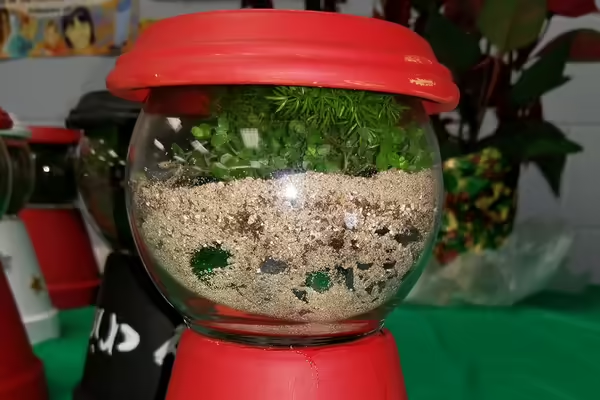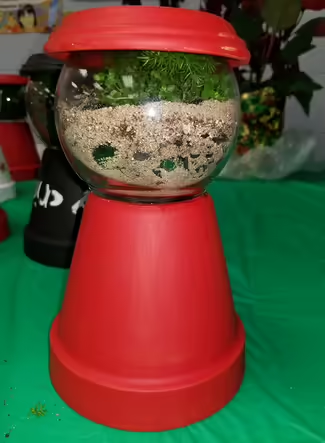
URBANA, Ill. — Leaves and temperatures are falling. As we prepare landscapes and gardens for winter, look towards indoor plant care to warm the mood. Giving plants for the holidays brings a little sunshine and warmth to those near and dear.
Impossible bottles or bottles with an object inside that doesn’t seem like it can fit through the bottle’s mouth have been things of wonder throughout history, with ships or decks of cards being built inside. Bottle terrariums are similar feats of wonder that use plants. Terrariums are either tightly closed or open transparent containers with plants inside. Credited for inventing terrariums in the 1800s, Dr. Nathaniel Bagshaw Ward used hermetically sealed glass containers with soil inside to better observe the change of the chrysalis of sphinx moths.
Creating Candy Jar Terrariums
Candy jar terrariums are a creative way to use plants and recycle old materials, and turning them into works of art is fun and whimsical. When starting a project a few items needed include a terracotta pot and saucer, paint, glue or epoxy, and a circular fishbowl for the structure. Paint the terracotta pot and saucer with desired colors or designs. When giving these for a holiday, choose colors that match that season or the personality of the recipient. After the paint has dried, use markers for additional designs or finishing touches. Glue or epoxy the fishbowl to the narrow side or typical bottom of the pot and allow it to set. Once the adhesive has been fully set, the fishbowl will become the space to create the terrarium.
This will be a semi-closed terrarium, which will act like a greenhouse and be a mini ecosystem. In-bottle terrarium caps, corks, or tightly fitting lids will trap the moisture inside where it will cycle. Open containers are more of a display, allowing for larger and taller plants. This candy jar will have a removable saucer lid.
Any transparent container can be used as a terrarium. Glass and plastic are the two most common mediums. Besides fishbowls, commonly used items are bottles, fish tanks, jugs, jars, or light bulbs.
Choosing the Theme
One favorite part of the project is coming up with a concept. Developing a theme based on an event, season, movie, or genre can help to tell a story and make a terrarium unique. Think of a terrarium as a room of the house where items can be switched out, like seasonal décor. This could be especially fun with holidays, like the next fall spooky season or winter holidays.
Preparing the Foundation
To build a terrarium, first start off with a drainage material such as gravel or stones. This allows water to pool without soaking the soil. When using foraged rocks or shells, boil them in water for five minutes to sterilize them and prevent disease or insect issues. Allow them to cool before using.
Add activated charcoal to help eliminate chemicals that could harm the plants. Activated charcoal can be found at garden centers. It is added to the terrarium to absorb any unwanted chemicals that would be taken up by the plant and cause adverse effects to the plant. Next, add a premoistened potting mix suitable for the chosen plants. The gravel, activated charcoal, and potting mix should make up about a quarter of the container’s volume.
Picking and Placing Features
Many plant types, such as Kalanchoe, Sempervivum, Crassula, Echeveria, and Sedum, can be used in terrariums. To add the plants, skewers, pipe cleaners, and long-handled tweezers may be needed depending on the size of the container’s opening. When placing plants, don’t let the foliage touch the sides of the container, and wipe any debris off plants with a clean paintbrush.
Clean any figures, toys, glass pebbles, or ceramic structures with an alcohol or 10% bleach solution and allow them to dry. Dried flowers or wood also may add to the story. Supplies can be purchased from dollar stores, craft shops, and local garden centers.
Tending to the Terrarium
To care for the new terrarium, place it near a south or western-facing window or near supplemental lighting, not in direct light. Most terrarium plants are in the medium light requirement category.
Watering will vary. Semi-closed containers will only need to be watered every four to six weeks, depending on the ambient humidity of its location. Wilting plants and bottles with no condensation are a sign watering is needed. Open containers need to be watered more often, depending on humidity levels in the home. Don’t overwater.
For maintenance, remove any dying leaves, turn the container weekly to keep plants growing normally, and prune or pinch plants that get tall.
Making terrariums is a great activity with family or friends, and they can make unique gifts for the holidays. For more information, watch our Creating a Bottle Terrarium webinar. For questions, connect with a local Extension office from the map.
Bruce Black is an Illinois Extension horticulture educator for Carroll, Lee, Whiteside, Boone, DeKalb, and Ogle counties. Gardeners Corner is a quarterly newsletter from gardening experts around the state. Each issue highlights best practices that will make your houseplants, landscape, or garden shine in any season. Join the Gardener’s Corner email list at subscribe for direct access to timely tips.
Photo Caption: A finished example of a candy jar terrarium. Photo by Bruce Black, Illinois Extension. Photo available for media download, including credits.
University of Illinois Extension develops educational programs, extends knowledge, and builds partnerships to support people, communities, and their environments as part of the state's land-grant institution. Extension serves as the leading public outreach effort for University of Illinois Urbana-Champaign and the College of Agricultural, Consumer and Environmental Sciences in all 102 Illinois counties through a network of 27 multi-county units and over 700 staff statewide. Extension’s mission is responsive to eight strategic priorities — community, economy, environment, food and agriculture, health, partnerships, technology and discovery, and workforce excellence — that are served through six program areas — 4-H youth development, agriculture and agribusiness, community and economic development, family and consumer science, integrated health disparities, and natural resources, environment, and energy.
